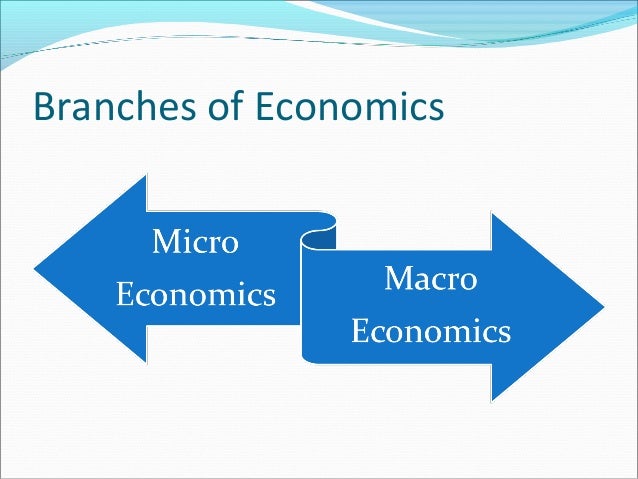Economics is the study of how people make choices under conditions of scarcity and the impact of those choices for people at an individual level and society at macro level .
 |
| Image Credit - https://www.slideshare.net |
Economics is further divided into two types which are
* Micro-Economics
* Macro-Economics
·Micro-Economics -
Micro-Economics is the study of behavior of individual and their decision on what to buy and consume based on prevalent price.
USES -
1) Micro-Economics deals with the understanding and working of a free market economy .
2)Micro-Economics helps us understand how the prices of the product and services get determined in an economy. How individuals and firm behave with regard to those prices and how goods and services in an economy are distributed along its various participants .
·Macro-Economics -
Macro-Economics deals with big pictures like that affects microeconomics for example GDP , Unemployment rates, overall price levels , inflation , saving rate, investment rates etc.
Various macro-economics variables are defined below -
1) National Income -
GDP, GNP (GROSS NATIONAL PRODUCT) etc. national income of an economy can be measured through three methods .
· Product Method -
In this method, national income is measured through aggregate flow of goods and services in economy from different sectors like agriculture ,industry and services.
· Income Method -
In this method , national income is measured as aggregate income of individual in the economy that is -
* Employees - Earn Wages .
* Professionals - Earn their income based on their services .
* Entrepreneurs - Earn profits .
* Investor - Earns return on capital and on rent .
- These are the different four types of working populations ☝.
Sum of these incomes for a specified period is called national income for the economy .
·Expenditure Method -
Consumers in an economy are broadly divided into three categories .
1) Individuals
2) Corporates
3) Government (export, import etc.)
The aggregate demand for goods and services is computed as the sum of private consumption, government spending , gross capital formation and net exports .
2) National Per Capita Income -
Per capita income or total income measures the average income earned per person in a given area in a specific year . It is calculated by dividing the area's total income by its total population . Per capita income is national income divided by population size .
In simple words, it is that, how much a individual is earning in a country .
India have its position of 122 as per GDP per capita (Source - worldometers.info) , well India is doing great but its population though which drags India's per capita income down .
3) Growth Of Sectors In GDP -
Let's understand it with an example -
The service sector constitutes 60 % of India's GDP at factory cost . Thus this is how this thing is calculated by taking getting all the information about sectors, about their performance and growth , and that's how it all works .
These are some points which can hit or have affects on the country's growth , there are some more things which are also important that is Government decisions or we can also say Fiscal Policies .
· Fiscal policies and their impact on economy
*Fiscal Deficit -
When government spends more than its total income, the phenomenon is known as fiscal deficit .
Main source of income for government is through Taxation and expenditure is Education , Healthcare , police , military forces , interest on borrowing , welfare benefit etc.
Fiscal deficit in a year means spending is more than its earning , so government has to take loans , more borrowing pushes the interest rate and make difficult to corporates to access funds . A higher interest rate environment is detrimental to economic growth .
*Monetary Policies And Their Impact On Economy -
Central bankers controls the money supply and interest rates with tools such as Repo Rate (Rate at which the central bank lends money to commercial banks) . Reverse Repo Rate (Rate at which the central banks borrows money from commercial banks) , Cash Reserve Ratio (Minimum percentage of total deposits , which commercial banks have hold as cash reserves with central banks) and Statutory Liquidity Ratio (SLR - minimum percentage of total deposits , which commercial bank have to hold in cash equivalent such as gold and govt. of India securities ) .
· International trade , exchange rate and trade deficit :-
The current account has all the details of transections on revenue about viz imports and exports of goods and services while the capital account captures all the capital flows like FDI,FII, loans and grants etc.
If imports are more than exports, then country will have a current account deficit and if exports are more than imports then it will have current account surplus .
Similarly, capital account will be in surplus if inflows are more than outflows and in deficit if outflows are more than inflows on capital account . Surplus and deficit on both current and capital accounts put together makes it balance of payments numbers for the country .
-------------------------------------------------------------------------------------------------------------
So that's it for the Economics analysis for more upcoming finance blog's update do follow me on -
Twitter - Akshit Thakur (@Axit682) / Twitter
LinkedIn - (3) Akshit Thakur | LinkedIn

Comments
Post a Comment